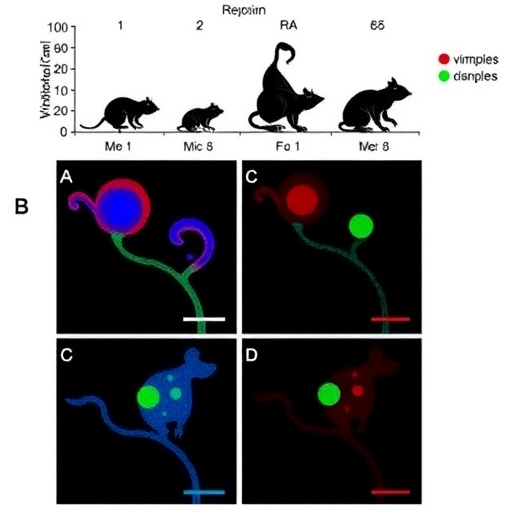In a groundbreaking study published in BMC Cancer, researchers have unveiled the profound impact of vincristine—a cornerstone chemotherapeutic agent used in pediatric oncology—on the musculoskeletal development of young mice. Despite the impressive survival rates exceeding 85% for children diagnosed with cancer, long-term complications following chemotherapy remain a significant concern. This research sheds light on the molecular and physiological consequences of vincristine exposure during a critical developmental window, raising pressing questions about its systemic effects on growing muscle and bone tissue.
Vincristine belongs to the vinca alkaloid class of drugs and is widely administered to treat a range of childhood cancers. While its anticancer efficacy is well documented, the extent to which vincristine influences other bodily systems, especially in pediatric patients undergoing crucial growth phases, has been less clear. This investigation, employing a pediatric mouse model, sought to delineate vincristine’s specific actions on muscle and skeletal integrity, areas critical to long-term health and functional capacity.
The study design involved administering vincristine intraperitoneally at a dose of 1.5 mg/kg twice weekly to four-week-old male C57BL/6J mice, a model chosen for its relevance to pediatric physiology. Over five weeks, researchers meticulously tracked body mass changes, followed by comprehensive assessments of muscle and bone health at the experimental endpoint. Control groups received vehicle injections, allowing for robust comparisons between treated and untreated cohorts.
Body mass emerged as a highly sensitive indicator of vincristine’s systemic toxicity, with treated mice exhibiting a striking 29% reduction compared to controls. This marked loss aligns with the multifaceted distress chemotherapy can impose on developing organisms and serves as a prelude to more specific tissue impairments observed in muscle and bone structures.
Skeletal muscle mass was profoundly affected, with the quadriceps, tibialis anterior, and gastrocnemius muscles showing reductions of 39%, 33%, and 25%, respectively. Such muscle atrophy signifies a disruption in normal growth and maintenance processes, suggesting that vincristine’s effects extend far beyond tumor cytotoxicity. The diminished muscle size corresponded with a 28% decline in ex vivo extensor digitorum longus (EDL) muscle force, a functional hallmark of impaired muscular performance.
Histologically, muscle fibers from vincristine-treated mice demonstrated a 22% decrease in cross-sectional area, indicating a reduction in individual muscle fiber size. Additionally, succinate dehydrogenase (SDH) staining revealed a metabolic shift away from oxidative fibers, which are typically endurance-oriented and mitochondria-rich, towards a glycolytic phenotype. This metabolic remodeling reflects compromised mitochondrial function and a potential reduction in muscle endurance capacity.
At the molecular level, the study identified a 267% increase in phosphorylation of the transcription factor STAT3 at tyrosine 705, a modification implicated in inflammatory signaling and muscle catabolism. Contrastingly, no significant changes in AKT phosphorylation at serine 473 were noted, suggesting a selective disruption of signaling pathways involved in muscle homeostasis. Upregulation of atrogenes such as Atrogin-1 and MUSA1 by over 100% fortifies the evidence for activated protein degradation pathways driving muscle wasting.
The mitochondrial biogenesis regulator PGC-1α was significantly reduced by 44%, further underscoring mitochondrial impairment. This decrease may compound the shift toward glycolytic muscle fibers and hamper the muscle’s capacity to meet energy demands, which could contribute to the functional deficits observed.
Parallel to muscle deterioration, vincristine induced significant bone loss in the developing mice. Micro-computed tomography (µCT) analyses revealed an 84% reduction in trabecular bone volume fraction (BV/TV), coupled with notable decreases in trabecular thickness and number. Connectivity density, a marker of structural integrity, plummeted by 89%, highlighting severe trabecular network disruption. These skeletal changes have profound implications for long-term bone strength and fracture risk.
Cortical bone was not spared, with a 21% thinning observed, indicative of compromised bone robustness and potential vulnerability to mechanical stress. The elevation of plasma CTX-1 levels by 51% suggests heightened osteoclastic activity and bone resorption, painting a clear picture of imbalanced bone remodeling favoring degradation over formation.
Taken together, these findings expose a dual assault of vincristine on muscle and bone development, mediated through molecular pathways involving enhanced proteolysis, mitochondrial dysfunction, and resorptive bone loss. This comprehensive characterization of vincristine’s extracancerous effects in pediatric mice underscores an urgent need for developing strategies to mitigate these adverse outcomes in childhood cancer survivors.
While chemotherapy remains indispensable in pediatric oncology, the long-term preservation of musculoskeletal health is paramount for improving quality of life post-treatment. This study propels the conversation towards integrating protective interventions alongside cancer therapeutics, potentially including targeted exercise programs, nutritional support, or pharmacologic agents designed to preserve muscle and bone integrity.
Future investigations should aim to delineate whether these deleterious effects observed in murine models translate directly to human pediatric patients and explore the reversibility of vincristine-induced musculoskeletal damage. Additionally, understanding the interplay between vincristine and other co-administered chemotherapeutics will be crucial to developing holistic supportive care protocols.
In conclusion, the elucidation of vincristine’s capacity to impair musculoskeletal development adds a vital dimension to pediatric oncology, highlighting that successful cancer treatment must also encompass strategies to safeguard the structural and functional capacity of the musculoskeletal system. As survival rates climb, the imperative to prioritize long-term health and functional outcomes becomes ever more significant, and studies such as this pave the way towards achieving that goal.
Subject of Research: Effects of vincristine chemotherapy on musculoskeletal development in pediatric mice.
Article Title: Vincristine impairs musculoskeletal development in pediatric mice.
Article References:
Jamnick, N.A., Livingston, P.D., Gammon, C.J. et al. Vincristine impairs musculoskeletal development in pediatric mice. BMC Cancer 25, 1782 (2025). https://doi.org/10.1186/s12885-025-15262-x
Image Credits: Scienmag.com
DOI: 10.1186/s12885-025-15262-x (Published 18 November 2025)




